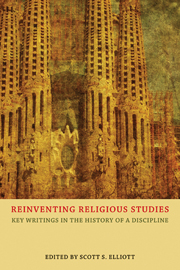Book contents
- Frontmatter
- Contents
- Introduction
- 1 For such a time as this: the Council of Societies for the Study of Religion, 1969–2009
- Part I Inventing and reinventing the field of religious studies
- Part II Method and theory in religious studies
- Part III Teaching religion
- Part IV Women and the bible in religious studies
- Part V Religion and religious studies in civic life
- Part VI Religious studies and identity politics
- Part VII Islam and 9/11
- Bibliography
- Acknowledgments
- Index
Introduction
- Frontmatter
- Contents
- Introduction
- 1 For such a time as this: the Council of Societies for the Study of Religion, 1969–2009
- Part I Inventing and reinventing the field of religious studies
- Part II Method and theory in religious studies
- Part III Teaching religion
- Part IV Women and the bible in religious studies
- Part V Religion and religious studies in civic life
- Part VI Religious studies and identity politics
- Part VII Islam and 9/11
- Bibliography
- Acknowledgments
- Index
Summary
My, how times have changed (or stayed the same, perhaps). That is such a cliché, I know. But it is a phrase that has come to mind time and again as I have worked on this project. My first editorial for the CSSR Bulletin (2004) reflected on the break-up of the American Academy of Religion (AAR) and the Society of Biblical Literature (SBL). Yet, in November 2011, following a trial separation, the two organizations again held their respective meetings on the same dates and in the same location (San Francisco, CA), albeit with very clear indications from both parties that the two organizations and their annual conferences were distinct. The oft-troubled waters of that relationship are symptomatic of a field that seems regularly out-of-tune with itself. This is not always a bad thing, necessarily, given the ways that such dissonance leads to critical reflection and fruitful production. Nevertheless, I suspect it is an aspect of the academic study of religion that causes our colleagues in other departments (to say nothing of those commoners wandering along the sidewalks outside our ivy-clad towers) to question, like the outsiders at Corinth (1 Corinthians 14:23), whether we are mad—and I dare say in more than one sense of the word.
Assembling this volume turned out to be a far more daunting task than I had imagined it would be when I first proposed it.
- Type
- Chapter
- Information
- Reinventing Religious StudiesKey Writings in the History of a Discipline, pp. ix - xviPublisher: Acumen PublishingPrint publication year: 2013



